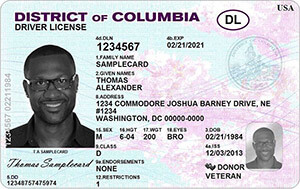

All your missed questions are saved
automatically for extra practice.




It's a practice test that's automatically made up of all your missed questions. Once you finish this test, you’ll be able to revisit your Challenge Bank™ to practice and sharpen your skills.
View All PlansAdding difficult questions to Challenge Bank™ is an exclusive Premium feature. Unlock access to 650+ exam-like questions, a Pass Guarantee, personalized study plans, and more.
View All PlansFree District of Columbia DMV Road Signs Permit Practice Test 2025
- Perfect for learner’s permit, driver’s license, and Senior Refresher Test
- Based on official District of Columbia Driver's manual
- Triple-checked for accuracy
- Updated for June 2025
Driving in the District of Columbia places you right in the nation’s capital. Beginners might get overwhelmed by the bustling traffic, multi-lane highways, and streets lined with government buildings and embassies. During rush hours, when congestion is at its peak, navigating the streets of DC can be a difficult challenge. Road signs keep the streets safe and help manage congestion, but all drivers must follow their indications.
To obtain a driver’s license in the U.S. capital, you should start with the learning phase. The District of Columbia Department of Motor Vehicles (DMV) publishes the official driver’s manual (District of Columbia DMV Handbook (DC Driver's Manual) 2025). Available in seven languages, this essential resource covers the various aspects of driving theory. There are several chapters dedicated to pavement markings and the most common road signs in DC. If you prefer to study while you practice and learn from your mistakes as they occur, use our District of Columbia DMV Road Signs practice tests. Updated for June 2025, this intuitive tool prepares you for the road signs questions featured on the official written knowledge test.
Each practice test has 25 multiple-choice questions. To pass, you must score at least 80%. For your convenience, we have omitted a timer so you can progress through each training session at your own pace. At the top-left corner of the page, the “Test settings” menu allows you to customize your experience. From here, you can activate the voiceover function. This feature uses an artificial voice to read the questions and answer choices aloud, making it easier for students with an auditory memory to retain information.
Do not get discouraged by a series of low scores. Take as much time as you need to understand every road sign described in the official driver’s manual. Becoming a safe and responsible driver in the District of Columbia takes more than passing exams. Our District of Columbia practice tests help you master the road signs by pointing out and correcting your mistakes as soon as they occur. Use your score to get an idea of your level of preparedness and take the official exam when you feel confident that you can pass.
What you need to know

What to expect on the actual DC DMV exam
questions
correct answers to pass
passing score
minimum age to apply
More resources
Are you in another state?
- Alabama: Test 1 / Test 2
- Alaska: Test 1 / Test 2
- Arizona: Test 1 / Test 2
- Arkansas: Test 1 / Test 2
- California: Test 1 / Test 2
- Colorado: Test 1 / Test 2
- Connecticut: Test 1 / Test 2
- Delaware: Test 1 / Test 2
- District of Columbia: Test 1 / Test 2
- Florida: Test 1 / Test 2
- Georgia: Test 1 / Test 2
- Hawaii: Test 1 / Test 2
- Idaho: Test 1 / Test 2
- Illinois: Test 1 / Test 2
- Indiana: Test 1 / Test 2
- Iowa: Test 1 / Test 2
- Kansas: Test 1 / Test 2
- Kentucky: Test 1 / Test 2
- Louisiana: Test 1 / Test 2
- Maine: Test 1 / Test 2
- Maryland: Test 1 / Test 2
- Massachusetts: Test 1 / Test 2
- Michigan: Test 1 / Test 2
- Minnesota: Test 1 / Test 2
- Mississippi: Test 1 / Test 2
- Missouri: Test 1 / Test 2
- Montana: Test 1 / Test 2
- Nebraska: Test 1 / Test 2
- Nevada: Test 1 / Test 2
- New Hampshire: Test 1 / Test 2
- New Jersey: Test 1 / Test 2
- New Mexico: Test 1 / Test 2
- New York: Test 1 / Test 2
- North Carolina: Test 1 / Test 2
- North Dakota: Test 1 / Test 2
- Ohio: Test 1 / Test 2
- Oklahoma: Test 1 / Test 2
- Oregon: Test 1 / Test 2
- Pennsylvania: Test 1 / Test 2
- Rhode Island: Test 1 / Test 2
- South Carolina: Test 1 / Test 2
- South Dakota: Test 1 / Test 2
- Tennessee: Test 1 / Test 2
- Texas: Test 1 / Test 2
- Utah: Test 1 / Test 2
- Vermont: Test 1 / Test 2
- Virginia: Test 1 / Test 2
- Washington: Test 1 / Test 2
- West Virginia: Test 1 / Test 2
- Wisconsin: Test 1 / Test 2
- Wyoming: Test 1 / Test 2
